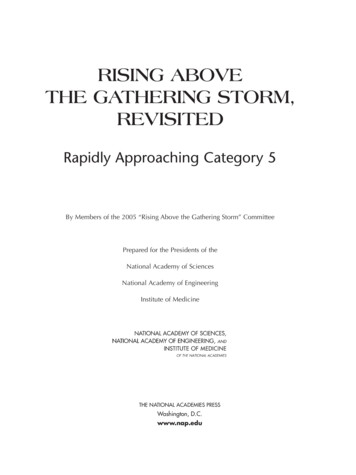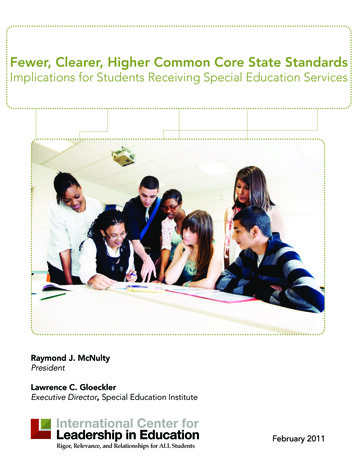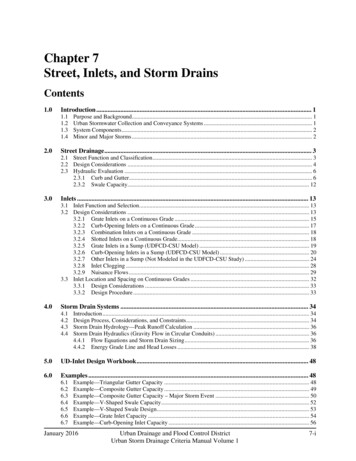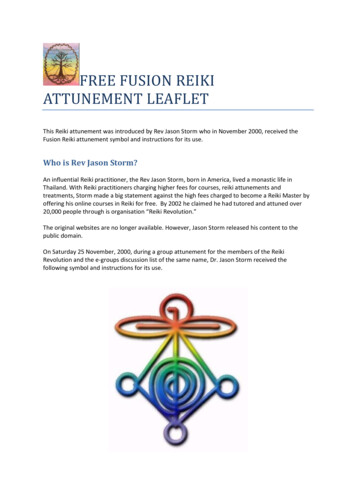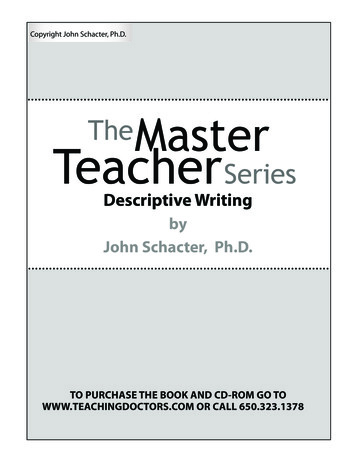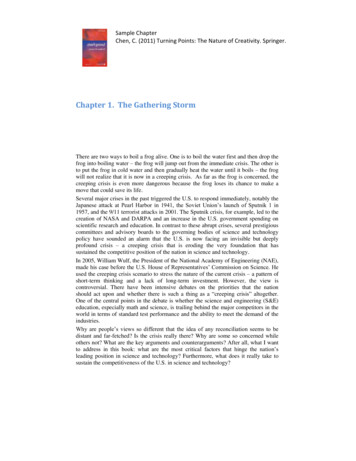
Transcription
Sample ChapterChen, C. (2011) Turning Points: The Nature of Creativity. Springer.Chapter 1. The Gathering StormThere are two ways to boil a frog alive. One is to boil the water first and then drop thefrog into boiling water – the frog will jump out from the immediate crisis. The other isto put the frog in cold water and then gradually heat the water until it boils – the frogwill not realize that it is now in a creeping crisis. As far as the frog is concerned, thecreeping crisis is even more dangerous because the frog loses its chance to make amove that could save its life.Several major crises in the past triggered the U.S. to respond immediately, notably theJapanese attack at Pearl Harbor in 1941, the Soviet Union’s launch of Sputnik 1 in1957, and the 9/11 terrorist attacks in 2001. The Sputnik crisis, for example, led to thecreation of NASA and DARPA and an increase in the U.S. government spending onscientific research and education. In contrast to these abrupt crises, several prestigiouscommittees and advisory boards to the governing bodies of science and technologypolicy have sounded an alarm that the U.S. is now facing an invisible but deeplyprofound crisis – a creeping crisis that is eroding the very foundation that hassustained the competitive position of the nation in science and technology.In 2005, William Wulf, the President of the National Academy of Engineering (NAE),made his case before the U.S. House of Representatives’ Commission on Science. Heused the creeping crisis scenario to stress the nature of the current crisis – a pattern ofshort-term thinking and a lack of long-term investment. However, the view iscontroversial. There have been intensive debates on the priorities that the nationshould act upon and whether there is such a thing as a “creeping crisis” altogether.One of the central points in the debate is whether the science and engineering (S&E)education, especially math and science, is trailing behind the major competitors in theworld in terms of standard test performance and the ability to meet the demand of theindustries.Why are people’s views so different that the idea of any reconciliation seems to bedistant and far-fetched? Is the crisis really there? Why are some so concerned whileothers not? What are the key arguments and counterarguments? After all, what I wantto address in this book: what are the most critical factors that hinge the nation’sleading position in science and technology? Furthermore, what does it really take tosustain the competitiveness of the U.S. in science and technology?
Sample ChapterChen, C. (2011) Turning Points: The Nature of Creativity. Springer.The Gathering StormThe notion that the U.S. is in the middle of a creeping crisis was most forcefullypresented to the U.S. House of Representatives’ Committee on Science on October 20,2005 1 . Norman R. Augustine, the chairman of the competitiveness assessmentcommittee, P. Roy Vagelos, a member of the committee, and William A. Wulf, thepresident of the National Academy of Engineering presented their assessments of thesituation. Augustine is the retired chairman and CEO of Lockheed Martin Corporationand Vagelos is the retired chairman and CEO of Merck. The full report was publishedby the National Academies Press in 2007, entitled Rising above the Gathering Storm(National Academy of Sciences, National Academy of Engineering, & Institute ofMedicine of the National Academies, 2007). In the same year, Is America falling offthe flat earth?, written by Augustine, is also published by the National AcademiesPress2 (Augustine, 2007).The Gathering Storm committee included members such as Nobel laureate JoshuaLederberg, executives of research-intensive corporations such as Intel and DuPont, thedirector of Lawrence Berkeley National Laboratory, and presidents of MIT, YaleUniversity, Texas A&M, Rensselaer Polytechnic Institute, and the University ofMaryland. The prestigious background of the committee and its starry members aswell as the well articulated arguments have brought a considerable publicity to thenotion of the creeping crisis – the gathering storm!The key points of the creeping crisis presented in the Gathering Storm committee canbe summarized as follows:1) America must repair its failing K-12 educational system, particularly inmathematics and science.2) The federal government must markedly increase its investment in basicresearch, that is, in the creation of new knowledge.The primary factor in this crisis is the so-called the Death of Distance, which refers tothe increasing globalization in all aspects of our life. Now the competitors andconsumers are all just a “mouse-click” away. Fast and profound changes in a widerange of areas are threatening the leading position of the U.S., for example, themobility of manufacturing driven by the cost of labor and the existence of a vibrantdomestic market. For the cost of one engineer in the United States, a company can hireeleven in India. More importantly, the Gathering Storm committee highlighted that theincreasing mobility of financial capital, human capital, and knowledge capital is nowaccelerating and deepening the crisis. On the other hand, competitors in mony/gathering storm energizing and employing america2.asp2The National Academies Press offers a free podcast free of charge athttp://books.nap.edu/catalog.php?record id 12021
Sample ChapterChen, C. (2011) Turning Points: The Nature of Creativity. Springer.countries have recognized the key mechanisms that sustain America’s competitivenessand are seeking to emulate the best of the America’s system. To assure that the U.S.does not fall behind the race, there is clearly a sense of urgency. According toAugustine,It is the unanimous view of our committee that America today faces aserious and intensifying challenge with regard to its future competitivenessand standard of living. Further, we appear to be on a losing path. We arehere today hoping both to elevate the nation’s awareness of thisdeveloping situation and to propose constructive solutions.Charles Darwin observed that “it is not the strongest of the species that survives, northe most intelligent, but the one most responsive to change.” In 1993, the COSEPUPcommittee (1993) recommended that the United States needs to be among the worldleaders in all fields of research in order to sustain the following key abilities: Bring the best available knowledge to bear on problems related to nationalobjectives even if that knowledge appears unexpectedly in a field nottraditionally linked to that objective. Quickly recognize, extend, and use important research results that occurelsewhere. Prepare students in American colleges and universities to become leadersthemselves and to extend and apply the frontiers of knowledge. Attract the brightest young students.The Gathering Storm committee has made a compelling case of a profound sense ofurgency and the need for action. The array of evidence include the choice ofinvestment: in 2005, for the first time in 20 years, US investors put more new moneyinto international stock funds than into US stock funds. The overseas fraction of newlyinvested stock funds in US changed from 8% in 1999 to 77% in 2005. In a survey ofthe attractive locations for new R&D facilities, 41% of the global corporations votedfor the U.S. and 62% for China. Augustine quoted a poem by Richard Hodgetts to sumup the urgency of the serious and intensifying challenge to America’s futurecompetitiveness and standard of living in a global environment:Every morning in Africa a gazelle wakes up.It knows it must outrun the fastest lion or it will be killed.Every morning in Africa a lion wakes up.It knows it must outrun the slowest gazelle or it will starve.It doesn’t matter whether you’re a lion or a gazelle –when the sun comes up, you’d better be running.Augustine (2007) noted that he was astonished by the degree to which foreign officialsare familiar with the Gathering Storm report. The Doomsday Scenario, as he described,would be the Gathering Storm succeeded in motivating others to do more and then the
Sample ChapterChen, C. (2011) Turning Points: The Nature of Creativity. Springer.U.S. did or sustained little. The U.S. Congress has passed the America COMPETESAct3 in 2007 to enact some of the recommendations made by the Gathering Stormcommittee. For example, the Act includes requirements to the National ScienceFoundation (NSF), the major funding agency of basic research: (Sec. 4006) Requires the NSF Director to: (1) consider the degree to whichNSF-eligible awards and research activities may assist in meeting criticalnational needs in innovation, competitiveness, the physical and naturalsciences, technology, engineering, and mathematics; and (2) give priority inthe selection of NSF awards, research resources, and grants to entities thatcan be expected to make contributions in such fields. (Sec. 4007) Prohibits anything in Divisions A or D of this Act from beingconstrued to alter or modify the NSF merit-review system or peer-reviewprocess. (Sec. 4008) Earmarks funds for FY2008-FY2011 for the ExperimentalProgram to Stimulate Competitive Research under the National ScienceFoundation Authorization Act of 1988.Despite the compelling creeping crisis case and the consensus of the need for action,many have raised serious questions that challenge the diagnostics and treatments of thecrisis. Indeed, multiple views, conflicting positions, and competing recommendationsneed to be validated, resolved, and implemented. Not only for policy makers but alsofor scientists, educators, students, and the general public, there is the urgent need formaking sense of what is really happening, and more importantly for understanding thespectrum of the long-term consequences of decisions made today.Into the Eye of the StormOne of the most forceful attacks of the Gathering Storm report is made by Into the Eyeof the Storm (Lowell & Salzman, 2007). The authors of the paper are Lindsay Lowellof Georgetown University and Hal Salzman of the Urban Institute. Their research wasfunded by the Alfred P. Sloan Foundation and the National Science Foundation.The key finding of the Into the Eye of the Storm is that their review of the data fails tofind support for the challenges identify by the Gathering Storm and those with similarviews. Specifically, they did not find evidence for the decline in the supply of highquality students from the beginning to the end of the S&E pipeline due to a decliningemphasis on mathematics and science education and a declining career interest amongthe U.S. domestic students in S&E careers. First, Lowell and Salzman showed that theclaim that the U.S. falls behind the world in science and mathematics is questionable;their data shows that the U.S. is the only country with a considerable diversity ofstudent performance and that simple rank positions make little sense in light of such 0761:@@@D&summ2 m&
Sample ChapterChen, C. (2011) Turning Points: The Nature of Creativity. Springer.degree of diversity. Second, their analysis of the flow of students up through the S&Epipeline suggests the supply of qualified graduates is far in excess of demand. Third,the more than adequate supply requires a better understanding why the demand sidefails to induce more graduates into the S&E workforce. Policy approaches to humancapital development and employment from prior eras do not address the currentworkforce or economic policy needs.Lowell and Salzman’s analysis shows that, from employers’ point of view, literacyand a competence in a broad range of subjects beyond math and science are essential.Furthermore, they rightly stated that the question is not about whether to improve theU.S. education system, but rather why U.S. performance is lower than other countries,what the implications are for the future competitiveness, and what polices would bestaddress the deficiencies. Their analysis draws attention to the fact that, according tothe 2006 U.S. Census, single-parent households with children under age 17 accountfor 33% of families in the United States, whereas the number is 17% in Norway andless than 10% in Japan, Singapore, and Korea. Therefore, it is unclear whether usingaverage test scores provide any meaningful indication of education or potentialeconomic performance of the United States because one could argue that it is thediversity and openness of the United States that contribute to its lower averageeducational performance as well as its high economic performance.Further analysis of the education-to-career pipeline shows that science and engineeringfirms most often complain about schools failing to provide students with the nontechnical skills needed in today’s firm.In summary, Into the Eye of the Storm concluded that the perceived labor marketshortage of scientists and engineers and the decline of qualified students are notsupported by the educational performance and employment data that Lowell andSalzman have reviewed. In contrast to the policy focus of U.S. competitivenesscommittees calling for the U.S. to emulate Singapore’s math and science educationprograms, Singapore’s recent competitiveness policy focuses on creativity anddeveloping a more broad-based education – an emulation of the U.S. education.The debates have made it clear that different questions should be asked: What are thefactors that have led to the consistent high performance of the U.S. economy? Whatkind of workforce is likely to improve prospects of the United States in the future?Lessons learned from the conflicting views underline that evidence-based policy isnecessary for developing effective programs for the emerging global economy. JuliaLane, the Program Director of the NSF Science of Science Policy Program, supportsevidence-based approaches to science policy.In a recent article published in the Scientific American, Beryl Lieff Benderly (2010), acolumnist for the Science Careers of the journal Science, addressed the question: Doesthe U.S. produce too many scientists? For example, she addressed practical issuesassociated with the fact that labs in the U.S. are typically staffed by graduate students
Sample ChapterChen, C. (2011) Turning Points: The Nature of Creativity. Springer.and postdoctoral researchers and new generations of graduates face an increasinglytough situation to land on a tenure track position in universities in the United States.Her article quickly attracted over 200 comments within days. Most comments spokefor personal experience in moving up along the education-to-career pipeline that theInto the Eye of the Storm studied.A manager in an engineering organization commented on what skills are needed inhis/her organization:“As a manger in an engineering organization, what I need are talentedBS and MS level engineers interested in hardware design, not PhDresearchers interested in basic science. Innovation that brings items tomarket drives the economy, not fundamental research. Only when theeconomy is producing marketable products can we afford the luxury ofbasic science; not to belittle the importance of science, but its rewardsare less immediate.”In terms of the metaphor of the education-to-career pipeline, BS and MS levelengineers would leave the pipeline much earlier than those who graduate with theirPhDs.In contrast, another commentator addressed the range of career options concerning thefar end of the pipeline, i.e. graduates with a Ph.D. and challenged the notion that thebest career move for a Ph.D. is a tenure track position in a research university:“A very valid and fruitful path is high-level engineering and science inthe industrial sector. I dare say that Google and Microsoft have morePhDs than many universities.” Yet another commentator expressed asimilar view: “When people say that we need more scientists andengineers, this is not what they mean. What they are talking about isthe need for more scientists and engineers that are going to tackle thedifficult problems of our time and being required to regularly justifywhat research you want (academic or industrial) funding is a goodthing.”Although the more attractive paycheck elsewhere in professions such as finance andlaw is often used to explain why people abandon the S&E career pipeline, some hasexpressed the view that scientists should not be wealth seekers. For example, anEuropean reader made the following comments:“As scientists, we don't (or shouldn't) pursue wealth. We do appreciatea decent salary AND, more important, some guarantee of stability, apension and a decent health care coverage .”A reader different pointed out that the reliance of America’s science on immigrants isnot something new:
Sample ChapterChen, C. (2011) Turning Points: The Nature of Creativity. Springer.“American science has always had a strong representation byimmigrants. We just need to go through the list of Nobel laureates forexample. So there is nothing like ‘Reversing the trend’ to how it was.It’s always been like that. The authors constant reference to "Nativeborn white men" is inappropriate. A large number of American highschool students excelling in international math and sciencecompetitions as pointed by the author himself are ethnically Asian orfrom India. Think about Steven Chu for example.”Throughout the widespread debates, some argue that the current volatile researchsystem is no more than a source of instability, and it is the instability that drives manygraduates off their originally chosen career paths. On the other hand, others believethat the instability and constant competitive is precisely where the U.S. science andtechnology draws its competitive strength. This is the same kind of natural selectionCharles Darwin talked about: the fittest will survive!The Yuasa PhenomenonA phenomenon first identified in 1960s by Japanese historian and physicist MintomoYuasa (1909-2005) may provide a different perspective to the already heated debateover the Gathering Storm. Yuasa analyzed world scientific activity records compiledfrom the Chronological Table of Science & Technology (in Japanese) and Webster’sBiographical Dictionary of Names of Noteworthy Persons with Pronunciations andConcise Biographies. He studied the trajectories of countries that claimed more than25% of the major scientific achievements of the entire world in the history and definedsuch countries as the centers of scientific activity. He noticed that the center ofscientific activity appears to move from one country to another periodically, every80 100 years! This is the Yuasa Phenomenon (Yuasa, 1962).Italy was the center for 70 years from 1540 till 1610. English was the center for 70years from 1660 till 1730. France was the center for 60 years from 1770 till 1830.Germany was the center for 110 years (1810-1920). The most interesting one is thecurrent center – the U.S. The U.S. became the current center 90 years ago, since 1920.According to the periodical pattern found by Yuasa, the shift of the U.S. as the worldscientific activity center could take place between 2000 and 2020. An equallyprofound question is: if the center does move, which country is likely to be the next? Ifthe Gathering Storm debate is viewed in this context, one has to wonder about thereasons behind such shifts.What can cause the center to drift away? Or equivalently, what makes the center tostay? Chinese scholar Hongzhou Zhao, not aware of Yuasa’s work, independentlydiscovered the same phenomenon. Zhao’s work was introduced to the western in 1985(Zhao & Jiang, 1985). However, it seems that their work is still not widely known tothe western world – as of 2010, their paper has been cited three times. It was first citedin 1987 by Schubert (1987) in a Scientometrics article on quantitative studies of
Sample ChapterChen, C. (2011) Turning Points: The Nature of Creativity. Springer.science. In 1993, it was cited in Psychological Inquiry by Hans Eysenck (1993) oncreativity and personality. He suggested a causal chain reaching from DNA to creativeachievement, based largely on experimental findings not usually considered in relationto creativity (e.g., latent inhibition). His model is highly speculative, but nonethelesstestable. The most recent citation to Zhao and Jiang’s paper was made by an article ona bibliometric model for journal discarding policy in academic libraries.Zhao introduced the notion of the social mean age of a country’s scientists at time t asthe average age of a scientist makes significant contributions: where Xb is the year of the birth of a scientist, Xi is the time when the scientist makesnoteworthy contributions, and Nt is the total number of scientists at time t. Zhaonoticed some interesting patterns: the At of 50 years old seems to be a tipping point.Immediately before a country becomes the center of scientific activity, the At of itsoutstanding scientists is below 50 years old. For example, Italy was the world center in1540-1610; the social mean age of scientists of Italy was 30 45 years old between1530 and 1570. Similarly, England was the center during 1660-1730 and its socialmean age was 38 45 between 1640 and 1680. France was the center 1770-1830 and itssocial mean age was 43 50 between 1760 and1800. Germany became the center in1810-1920 and its social mean age was 41 45. The U.S. has been the center since1920 and its social mean age of scientists was about 50 between 1860 and 1920.On the other hand, if the social mean age of scientists in the host country of the currentcenter of scientific activity exceeds 50 years old, it tends to lose the its center position.For example, the At of France started to exceed 50 years old in 1800; by 1840, thecenter shifted to England. Why is the age of 50 so special?As we shall see in Chapter 2, Zhao approached to this question from a statisticalperspective and defined the concept of an optimal age – a period of the most creativeyears in the career of a scientist. Zhao found that when a country’s social mean ageapproaches the distribution of the optimal ages of the scientists in the country, thecountry’s science is likely on the rise; otherwise, it is likely to decline. The estimationof the optimal age is built on his theory of scientific discovery. We will re-visit Zhao’swork in more detail in Chapter 2.A different approach to the question was offered by Zeyuan Liu and Haishan Wang in1980si. They found that a country’s status of the world center of scientific activitiesappeared to follow a 60-year leading period of revolutions of philosophy in the samecountry. In other words, philosophical revolutions lead scientific revolutions.Furthermore, a macroscopic chain of revolutions was found in England, France, andGermany: philosophical political scientific industrial revolutions. Forexample, Italy experienced its philosophical revolution in 1480, which was 60 years
Sample ChapterChen, C. (2011) Turning Points: The Nature of Creativity. Springer.before it became the scientific center of the world in 1540. England’s philosophicalrevolution began in 1600, also 60 years ahead of its status as the world center ofscientific activities in 1660.The social mean age of scientists, the optimal age of scientists in a country, and thepresence or absence of a philosophical revolution provide a set of interestingmacroscopic-level indicators. On the other hand, finer-grained theories and models ofscientific discovery are necessary to investigate any substantial connectionsunderlying these observations. Furthermore, while macroscopic observations provideinteresting backdrops of scientific activities, many questions are unlikely to beanswered precisely unless we take the development of scientific fields into account.Transformative Research and the Nature of CreativityThe Death of Distance is ubiquitously behind the globalized and intensifiedcompetitions in and across all areas of economy, culture, politics, education, andscience and technology. Taxpayers, small business, large corporate companies,schools and universities, and government agencies are all under tremendous pressureto act. Darwin’s natural selection is undertaking a whole new wave of variations andtaking place at an unprecedented rate and scale.From a sociological perspective of the philosophy of science, Randall Collins (1998)argued that intellectual life is first of all conflict and disagreement. His insight is thatthe advance of an intellectual field is very much due to rivalry and competing schoolsof thought that are often active within the same generational span of approximately 35years. He introduced the notion of attention space and argued that “creativity is thefriction of the attention space at the moments when the structural blocks are grindingagainst each other the hardest.” (p. 76). The attention space is restructured by pressingin opposing directions. He spent over 25 years to assemble intellectual networks ofsocial links among philosophers whose ideas have been passed along in latergenerations. He constructed such networks for China, India, Japan, Greece, modernEurope, and other areas over very long periods of time. He used a generation ofphilosophers as a minimal unit for structural change in an intellectual attention space.For example, it took 6 generations to move from Confucius to Mencius and ChuangTzu along the Chinese intellectual chains. Figure 1.1 shows an example of theintellectual network of Chinese philosophers between 400BC and 200BC. A majordifference between Collins’ grinding attention space and Kuhn’s competing paradigmsis that for Collins explicit rivalry between schools of thought often developed insucceeding generations (Collins, 1998. p. 6), whereas Kuhn’s competing paradigmsare simultaneous. Major philosophers (labeled with all capital letters) such as Menciusand Kung-Sun Lung are all at the center of colliding perspectives.The image is available in the printed edition.
Sample ChapterChen, C. (2011) Turning Points: The Nature of Creativity. Springer.Figure 1.1. A social-intellectual network of Chinese philosophers (400-200 B.C.). Source:Figure 2.1 in (Collins, 1998) (p. 55).Figure 1.2 depicts the intellectual footprints of the field of nanoscience between 1997and 2007. It shows how fast a field has been moving forward and how much of theliterature has been left behind. Each small dot in the image represents an article thatwas cited by researchers in the field. Each dot is surrounded by tree-rings of citationsthat the article received. A bigger-sized disc indicates that the corresponding articlehas been cited more often than an article with a smaller-sized disc. The majority of thearticles on the left-hand side were cited by the field around the beginning of thetimeframe, i.e. late 1990s. The bluish colors of articles in this area indicate that thefield no longer cited much of them for a long time. In contrast, the right-hand side isfull of recent activities. The colors of the citation rings in this area are warmer andbrighter, indicating more recent citations. The citation tree rings of a few articles havelayers of rings in red. It means that these articles experienced a significant surge ofcitations. They were at the center of the attention of the field. They were the hot topics.Figure 1.2. The intellectual trails of the field of nanoscience between 1997 and 2007.Figure 1.3 shows not only a map of the Universe but also discoveries and researchinterests associated with various areas in the Universe. The earth is at the center of the
Sample ChapterChen, C. (2011) Turning Points: The Nature of Creativity. Springer.map because the distance to an astronomic object is measured from the earth. The blueband of galaxies and the red band of quasars were formed at the early stage of theUniverse. As the Universe expands, they become further away from us. The HubbleUltra Deep Field, shown at the upper-right corner of the image, was one of the farthestobservations made by scientists. Unlike the free-form layout method used ingenerating the visualization shown in Figure 1.2, the map of the Universe preservesthe relative positions of astronomic objects. It is common in cartography to use a basemap as the general organizational framework and then add various thematic layers ontop of it. Adding multiple thematic layers is in effect combining information frommultiple perspectives. A fundamental question has yet to be answered is how oneshould interpret the meaning of such combinations. Each perspective represents itsown conceptual space, which may or may not be compatible with other spaces. Thecompatibility here means whether there exists a topological mapping from one spaceto another. A central property of topological mapping is that it reserves the proximityrelations so that nearby points in one space will remain to be neighbors when they aremapped into a new space. This is obviously not held between the astronomical spaceand the space of astronomical knowledge. Two black holes may be further apart in theUniverse, but they can be dealt with by the same theory in the knowledge space. Incontrast, two different theories may address the same phenomenon in the Universe.Figure 1.3. A map of the Universe with overlays of discoveries and astronomical objectsassociated with bursts of citations. The close-up view of the Hubble Ultra Deep Field isshown at the upper-right corner (circled).
Sample ChapterChen, C. (2011) Turning Points: The Nature of Creativity. Springer.In May 2009, as H1N1 was rapidly spreading across many countries, there was a richbody of knowledge about influenza pandemics in the literature. The Web of Sciencealone indexed over 4,500 research papers on influenza and pandemics. Figure 1.4shows a timeline visualization of this literature as of May 8th, 2009.4 Spots in red werearticles with a burst of citations. In contrast, Figure 1.5 shows a similarity
by the National Academies Press in 2007, entitled Rising above the Gathering Storm (National Academy of Sciences, National Academy of Engineering, & Institute of Medicine of the National Academies, 200

